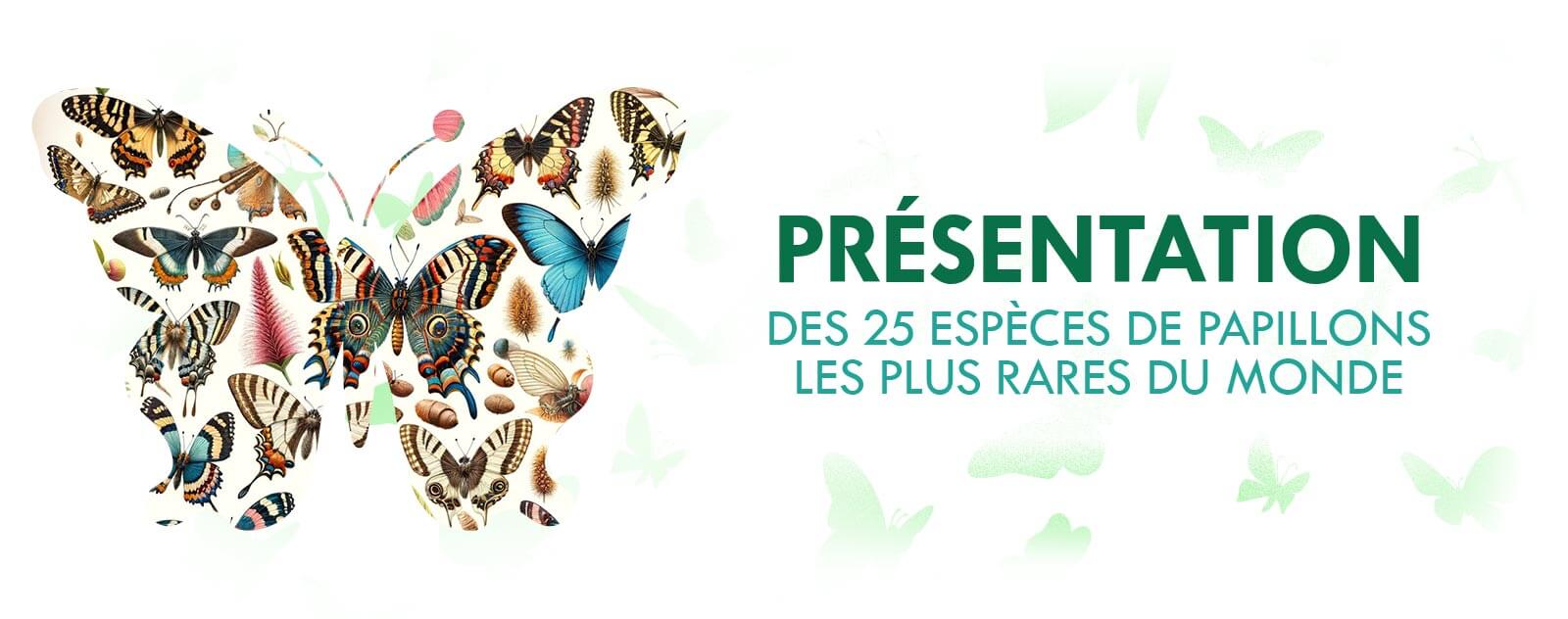Butterflies, these winged creatures, embody the delicacy and diversity of nature. Beyond their ephemeral beauty, they play a crucial role in ecosystems as pollinators and indicators of environmental health. Among the thousands of Lepidoptera species, some stand out for their rarity, making their discovery even more fascinating.
This article invites you on a journey around the world to discover 25 of the rarest butterfly species, true jewels of biodiversity.
After reading, you will be able to discover two other articles that might interest you:
The Architects of Nature: The 25 Rarest Butterflies

The biodiversity of butterflies is a testimony to the ingenuity of nature. These 25 rare species offer an overview of the ecological richness of our planet and the urgency of its preservation.
1. The Jade Butterfly (Graphium agamemnon)
Native to the tropical forests of Asia, the Jade Butterfly is distinguished by its translucent emerald green wings. Its rarity is accentuated by deforestation which threatens its natural habitat.
2. Glaucus Blue (Glaucopsyche arion)
This European butterfly, with its intense blue wings, is in decline due to intensive agriculture destroying the grasslands where it resides and breeds.
3. Queen Alexandra's Ornithopter (Ornithoptera alexandrae)
This giant among butterflies, endemic to New Guinea, is threatened by illegal trade due to its impressive size and vibrant colors.
4. The Karner Blue (Lycaeides melissa samuelis)
This small blue butterfly, found in the prairies of North America, is critically endangered due to the loss of its habitat, wild lupine.
5. The Monarch Butterfly (Danaus plexippus)
Although widely known, the Monarch is in rapid decline due to the destruction of its breeding grounds and the milkweed plants on which its caterpillars depend.
6. The blue Morpho (Morpho menelaus)
This spectacular butterfly, famous for its iridescent blue wings, is a victim of deforestation in South America.
7. The Thistle Moth (Vanessa atalanta)
This butterfly, which migrates long distances, is affected by climate change which disrupts its traditional migratory patterns.
8. The Bhutan Swallowtail (Bhutanitis lidderdalii)
This magnificent butterfly, with its swallow-tail wings, is extremely rare and found only in certain parts of Bhutan.
9. The Moon Moth (Actias luna)
This North American butterfly, with its long green tails and translucent markings, is increasingly rare due to the use of pesticides.
10. The Batwing (Atrophaneura semperi)
This unique species, with its dark, bat-like wings, is native to the Philippines and is threatened by forest loss.
11. Chilean Blue Argus (Hemiargus hanno)
This butterfly, with its shimmering blue hues, is unique to Chile but is threatened by increasing urbanization.
12. The Swallow-tailed Butterfly (Papilio machaon)
This widely distributed butterfly has become rare in many regions due to the intensive use of insecticides.
13. The Glasswing (Greta oto)
This Central American butterfly, with its unique transparent wings, is threatened by deforestation and pollution.
14. The Purple Emperor (Apatura iris)
This large European butterfly, known for its iridescent reflections, is in decline due to forest management which reduces its habitat.
15. The Luna Moth (Actias luna)
With its large green wings and long tails, this North American moth is threatened by artificial light which disrupts its breeding patterns.
16. Queen of the Andes (Spectrocnemis caerulescens)
This rare butterfly, found only in the Andes mountains, is endangered due to climate changes affecting its alpine habitat.
17. The Cethosia biblis
This colorful butterfly, found in Southeast Asia, is threatened by deforestation and land conversion to agriculture.
18. The Tiger Butterfly (Danaus chrysippus)
This butterfly, widespread in tropical regions, is vulnerable to habitat changes and the use of pesticides.
19. The Black Swallowtail (Papilio polyxenes)
This North American butterfly is threatened by the disappearance of its host plants due to urbanization and intensive agriculture.
20. The Great Purple Hairstreak (Atlides halesus)
This North American butterfly, known for its metallic purple hues, is affected by habitat loss and pesticide use.
21. The Satyr Comma (Polygonia satyrus)
This butterfly, characterized by its angular shape and earthy colors, is threatened by deforestation and climate change.
22. The Emerald-tailed Butterfly (Papilio palinurus)
This Southeast Asian butterfly, with its magnificent emerald green wings, is in decline due to deforestation.
23. The White Admiral (Limenitis arthemis)
This butterfly, found in the forests of North America, is vulnerable to forest management that disrupts its natural habitat.
24. The Peacock Pansy (Junonia almana
This butterfly, with its unique peacock-like patterns, is threatened by urbanization and deforestation in South Asia.
25. The Silvery Blue (Glaucopsyche lygdamus)
This small blue butterfly, widespread in North America, is threatened by the loss of its meadow habitats.
Preserving these species requires a global commitment to habitat conservation, scientific research and environmental education. Each species plays a crucial role in its ecosystem, and their protection is essential to maintaining the biodiversity and health of our planet.
Winged Jewels: Rare Species and their Habitat
Rare butterflies are often sentinels of their habitats, whose conservation is essential for their survival. From tropical rainforests to temperate grasslands, each species requires a specific ecosystem to thrive. For example, the Blue Serpolet (Phengaris arion) depends on sunny meadows where thyme, its host plant, grows. The habitat of these butterflies is threatened by urbanization, intensive agriculture, and climate change, making the protection of these environments more crucial than ever.
The larvae of these rare butterflies develop symbiotic relationships with certain host plants, on which they feed after hatching. Dependence on specific plants makes these butterflies particularly vulnerable to habitat disturbance. The conservation of host plants and the restoration of natural habitats are therefore fundamental to preserving these rare species.
The fore and hind wings of these butterflies are not only marvels of nature in design and color, but they also serve as tools of camouflage or seduction during the mating ritual. Evolution has given these butterflies unique patterns and colors to protect themselves from predators or attract mates, illustrating the complexity of life on Earth.
Life Cycle and Unique Adaptations
The life cycle of a butterfly, from larva to imago, is a fascinating process that demonstrates the complexity of evolution. Caterpillars, the larval phase of butterflies, are often adapted to very specific diets, making them particularly sensitive to environmental changes. For example, the Monarch Butterfly caterpillar (Danaus plexippus) feeds exclusively on the Milkweed plant, and any decline in this plant can have devastating effects on its population.
The metamorphosis of chrysalis into butterfly is one of the most mysterious and magnificent processes in nature. This transformation, requiring ideal environmental conditions, is crucial for the survival of the species. Butterflies emerge with delicate wings covered in colorful scales, ready to begin their brief but important existence.
The unique adaptations of these butterflies, such as sensitive antennae and specialized proboscis for sucking nectar, highlight the importance of biodiversity. These traits allow butterflies to pollinate many plant species, contributing to the overall health of ecosystems.
Butterflies and Scientific Research
Scientific research on rare butterflies offers valuable insights into their biology, ecology and factors that threaten their existence. By better understanding the lifestyle habits and specific needs of butterflies, researchers can develop more effective conservation strategies. Population genetics, the study of diseases and parasites, and the impact of climate change on these species are important areas of research.
In conclusion, butterflies are not only symbols of natural beauty, but also essential players in biodiversity and ecological health. Preserving the world's 25 rarest butterfly species is a shared responsibility that requires concerted efforts in conservation, research and education. By protecting these fascinating creatures, we safeguard not only their existence but also the richness and balance of life on our planet.






TALON
Bonsoir
Merci pour votre réponse.
Il semble que ce soit Eurybia Caerulescens
Berty Talon
Dayana
Bonjour, le papillon “La Reine des Andes” (Spectrocnemis caerulescens) semble rare, et les informations à son sujet sont limitées, ce qui peut indiquer que “Reine des Andes” soit une appellation locale. Pour obtenir des informations détaillées, il est conseillé de consulter des ressources spécialisées comme Butterfly Conservation, l’Entomological Society, ou des plateformes comme iNaturalist et Butterflies of America. Ces communautés en ligne et forums d’entomologie peuvent également vous aider à identifier le papillon si vous disposez d’une photo. Bonne journée, Dayana
TALON
Bonjour,
Je n’arrive pas à trouver d’informations sur le papillon "La reine des Andes (Spectrocnemis Caerulescens). Pourriez vous m’envoyer une Fiche/Photo.
Merci d’avance pour votre retour
Berty Talon